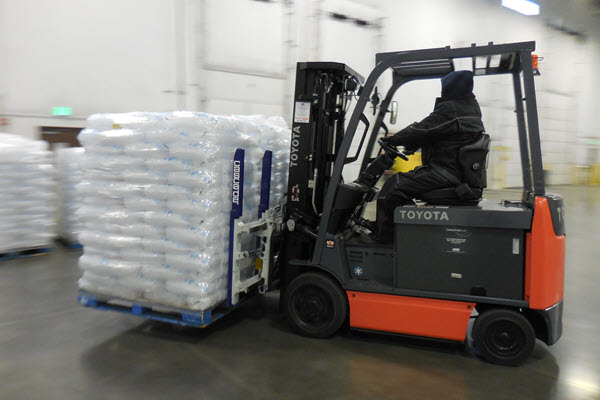Lift Truck Tips: Conventional in the cold
With a disciplined approach to maintenance, data-driven insight on charging and a cold condition package, you can ensure adequate performance in the cold.
With new power options like hydrogen-powered trucks and lithium-ion batteries emerging that perform better than conventional lead-acid batteries in cold storage environments, some cold storage operations aren’t inclined to make the move into hydrogen or lithium yet. With extra care, you can ensure lead-acid powered trucks have the power to perform.
For starters, it’s wise to select a truck that has a “cold condition” package, says Pete Thomas, director of sales with Toyota Material Handling Northern California. These packages typically involve features such as additional grease fittings, an enclosed motor drive, rust inhibitor, stainless steel linkage pins, as well as special freezer oil, tilt cylinder boots, and heaters. Most of these features are to protect against condensation and moisture buildup, Thomas says.
Hydrogen-powered lift trucks do perform extremely well in cold storage, says Thomas, but the fueling infrastructure and other costs can be daunting for operations accustomed to lead-acid. Lithium-powered electric trucks can be an easier transition, he adds, in that many electric trucks can accept and use lithium packs.
Cold reduces run time for standard lead-acid batteries, reducing capacity by up to 35% versus use in ambient temperatures, says Thomas. Lithium batteries cost more, but are less effected by cold temperatures, which cuts the need for swaps and saves on battery room space.
“Warehouse space is important, especially for cold storage operations,” says Thomas. “Lithium could become a game changer for cold storage because you get longer run times on the equipment [vs. conventional lead-acid], and you can free up warehouse space. But conventional lead-acid can work well in cold storage, you just have to factor in the reduced run time, and use a lift truck with proper cold-condition features.”
For Americold, a major operator of cold storage warehouses and services, the most common source of lift truck power in its network remains lead-acid batteries, though the company has explored multiple technologies, says Duane Fortenberry, manager of maintenance capital for Americold.
Fortenberry advises to use a battery management system to take the guesswork out of the use and charging processes and to partner with vendors to size the total amps for your battery pool to your fleet of trucks and operational requirements. These systems monitor charging and help with issues like proper cool down and equalization cycles, as well as indicate which charged batteries should be used next.
Americold does opt for electric lift trucks with a cold condition package, Fortenberry says, and also has begun using some thin-plate pure lead (TPPL) batteries in some operations, but he says given the right approach, lead-acid can do the job in cold storage.
Of course, some operations may find that the best route to cold storage productivity is adopting hydrogen fuel cells (HFCs). “HFCs are an ideal power source for applications like cold storage lift trucks as there is no power degradation in the face of extreme temperatures,” says Andy Marsh, CEO of Plug Power, a HFC provider. “Plug Power has fuel cells operating successfully in temperatures as low as -30°F. Additionally, much like your car, as long as there is hydrogen in the HFC the unit will run at full power.”













